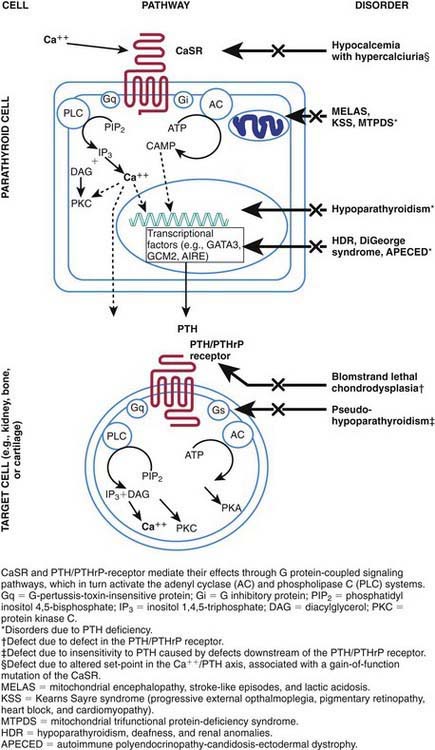Chapter 564 Hormones and Peptides of Calcium Homeostasis and Bone Metabolism
Parathyroid hormone (PTH) and vitamin D are the principal regulators of calcium homeostasis (Chapters 48 and 694). Calcitonin and PTH-related peptide (PTHrP) are important primarily in the fetus.
Parathyroid Hormone
PTH is an 84–amino-acid chain (9,500 d), but its biologic activity resides in the first 34 residues. In the parathyroid gland, a pre-pro-PTH (115-amino-acid chain) and a proparathyroid hormone (90 amino acids) are synthesized. Pre-pro-PTH is converted to pro-PTH and pro-PTH to PTH. PTH(1-84) is the major secretory product of the gland, but it is rapidly cleaved in the liver and kidney into smaller COOH-terminal, mid-region, and NH2-terminal fragments.
The occurrence of these fragments in serum has led to the development of a variety of assays. The 1-34 amino-terminal (N-terminus) fragments possess biologic activity but are present in low amounts in the circulation; assay of these fragments is most useful for detecting acute secretory changes. The carboxy-terminal (C-terminus) and mid-region fragments, although biologically inert, are cleared more slowly from the circulation and represent 80% of plasma immunoreactive PTH; values of the C-terminal fragment are 50-500 times the level of the active hormone. The C-terminal assays are effective in detecting hyperparathyroidism, but because C-terminal fragments are removed from the circulation by glomerular filtration, these assays are less useful for evaluating the secondary hyperparathyroidism characteristic of renal disease. Only certain sensitive radioimmunoassays for PTH can differentiate the subnormal concentrations that occur in hypoparathyroidism from normal levels.
When serum levels of calcium fall, the signal is transduced through the calcium-sensing receptor, and secretion of PTH increases (Fig. 564-1). PTH stimulates activity of 1α-hydroxylase in the kidney, enhancing production of 1,25-dihydroxycholecalciferol, also written 1,25(OH)2D3. The increased level of 1,25(OH)2D3 induces synthesis of a calcium-binding protein (calbindin-D) in the intestinal mucosa, with resultant absorption of calcium. PTH also mobilizes calcium by directly enhancing bone resorption, an effect that requires 1,25(OH)2D3. The effects of PTH on bone and kidney are mediated through binding to specific receptors on the membranes of target cells and through activation of a transduction pathway involving a G-protein coupled to the adenylate cyclase system (Chapter 566).

Full access? Get Clinical Tree



